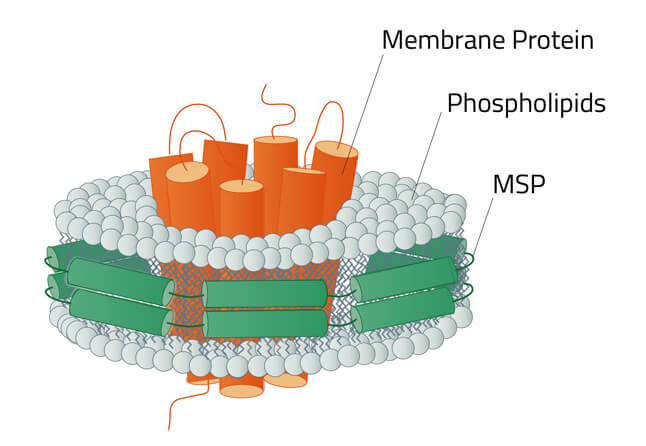MSP1D1-D73C-His, lyophilized protein
Order number: 27212
Description
Membrane scaffold proteins derive from apolipoprotein (apo; A-I). They are used in membrane protein sciences for the stabilization of membrane proteins in a lipid environment after the removal of the cell membrane. The size of the nanodisc is determined by the MSP that was used to create the disc. MSP1D1 D73C creates nanodiscs of 9-10 nm in diameter.
This product contains an additional point mutation, D73C. This additional cystein can be used to further modify the MSP protein and this the nanodisc. And example for such a modification would be the addition of a biotin-tag.
Other MSP products or related sites by Cube Biotech include:
This product contains an additional point mutation, D73C. This additional cystein can be used to further modify the MSP protein and this the nanodisc. And example for such a modification would be the addition of a biotin-tag.
Other MSP products or related sites by Cube Biotech include:

Datasheets
| Feature | |
|---|---|
| Purity | > 90% (Determined by SDS-PAGE) |
| Origin | Human |
| Number of Amino Acids | 217 |
| Molecular Mass | 25,298 Da |
| Extinction coefficient (in water) ε280 | 25,440 M-1cm-1 |
| Buffer | 20 mM TRIS pH 7.4; 100 mM NaCl; 0.5 mM EDTA |
| Sequence (1-Letter Code) | MGSSHHHHHH ENLYFQ GLKLLDNWDSVTSTFSKLREQLG PVTQEFWCNLE KETEGLRQEMS KDLEEVKAKVQ PYLDDFQKKWQEEMELYRQKVE PLRAELQEGARQKLHELQEKLS PLGEEMRDRARAHVDALRTHLA PYSDELRQRLAARLEALKENGG ARLAEYHAKATEHLSTLSEKAK PALEDLRQGLL PVLESFK VSFLSALEEY TKKLNTQ |
| Affinity tag | N-Terminal His-tag |
| Shipping Temperature | Room Temperature |
| Storage of lyophilized protein | -20°C for several months |
| Storage of reconstituted protein | 2-8°C for several days |
| Helpful literature references |
|
Video
Watch our video tutorial about the creation of MSP nanodiscs. It explains the whole process, starting with the initial solubilzation using detergents. The protein that was stabilized in this demonstration was Bacteriorhodopsin.
We also recommend our video guide to nanodiscs in general.
We also recommend our video guide to nanodiscs in general.
FAQ
Can I get the datasheet for the MSP1D1 D73C protein?
Is this the correct MSP product for my membrane protein?
This cannot be answered easily as every membrane protein performs differently with each nanodisc size and phospholipid. It usually requires a screening process before. Remember that membrane proteins with fewer transmembrane domains (TMD) require a smaller nanodisc, while a high number of TMDs need a larger nanodisc.
I have never worked with MSP nanodiscs before. Can you tell me more about them?
Of course! In fact we created THIS MSP NANODISC GUIDE PAGE, for this purpose. Have a look at it!
Are there other options to stabilize membrane proteins besides MSP nanodiscs?
Yes, there are. We recommend synthetic copolmer nanodiscs greatly! Have a look at THIS GUIDE PAGE to learn more.



